Since her last blog, Project Conservator Mhairi Boyle has been getting to work assessing and conserving the bound volumes from the R(D)SVS and OneKind archives. In this blog, she explains the assessment process used to evaluate the condition of OneKind’s bound volumes.
In my last blog I was at the Zoo, helping to move the archive on a warm yet rainy summer’s day. It’s now a crisp October and I am stationed back at the Main Library, tasked with conserving the bound volumes in the OneKind and R(D)SVS collections.
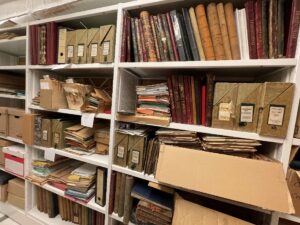
The OneKind archive, before rehousing
First, I had to decide where to start. When working on a long-term project, it’s important to establish an efficient workflow. This project is a little bit different than anything else I have worked on because all the collections were either partially catalogued or not yet catalogued. Project Archivist Fiona Menzies is hard at work establishing an order and organising the metadata for each collection, which means that over time many of the items and boxes will change location. To not disrupt the cataloguing and organisational processes, I decided to start with the larger bound volumes in the R(D)SVS and OneKind collections.
Upon initial examination, it was clear that the OneKind volumes needed more attention than the R(D)SVS ones. I decided to undertake a more detailed survey of the OneKind volumes to provide an overview of their condition and identify the most common issues. Surveys often go at snail’s pace in the beginning, as you get to know the collection and the common conservation issues and the extent to which objects are damaged. As I got to know the collection, I was able to create damage categories to assign to each volume. I created Categories 1-4, from ‘Good’ to ‘Fair’ to ‘Poor’ to ‘Severe Multiple Damages’. ‘Good’ volumes are in stable, functional condition and require little/no interventive conservation treatment, and the other categories represent a sliding scale of object condition.
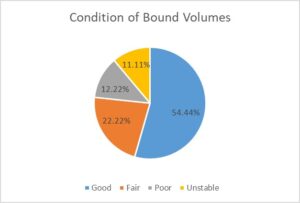
The survey gave me an overview of the condition of the collection
The most common issues were surface dirt; red rot (the deterioration of the leather cover and/or spine); and damaged leather covers and/or spines.
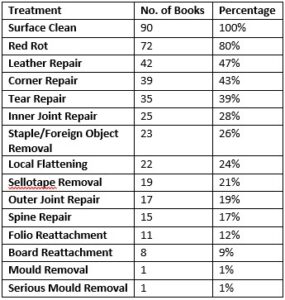
Surface dirt, red rot, and damaged leather are the orders of the day!
However, the most complex issue with the collection is the amount of Sellotape on many volumes. In many cases, extensive tape has been applied to volumes with damaged/detached boards and/or spines, to keep the volume intact. This will prove to be tricky to remove, because whilst in some areas the adhesive has hardened and come away from the plastic carrier, in many areas it is still fully adhered to the leather. Removing it may in fact further damage the leather.
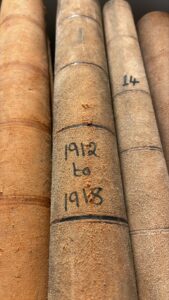
Red rot galore. This deteriorated leather can be consolidated with Klucel G in Industrial Methylated Spirit
The removal of the tape is one of many ethical decisions which must be considered when treating the OneKind collection. Because this is an archival rather than a fine art collection, the preservation of information is of utmost importance. Because the bindings of the volumes are not historically unique, an in-situ and minimally interventive approach to the treatments will be adopted. To maximise efficiency and speed, tape will be left as-is on areas of the volumes where it does not affect the movement and functionality of the volumes. This will not affect the quality of the treatment, allowing me to preserve the whole collection rather than completely rebinding singular volumes.
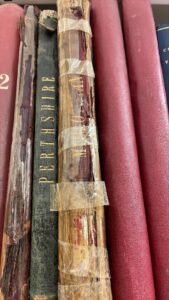
Tape has held this volume together. Now, it can be replaced with archival-friendly conservation treatments
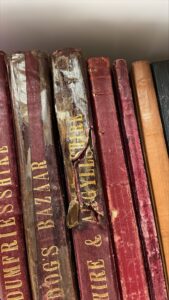
Did somebody say tape?
In a way, I must be thankful for all the tape that I am going to tackle. A well-meaning person recognised the importance of keeping the volumes intact and put in their best efforts to preserve them in their original formats. It means that no boards or spines have been lost into the ether. I will be sure to update when I begin my tape-laden conservation journey!
